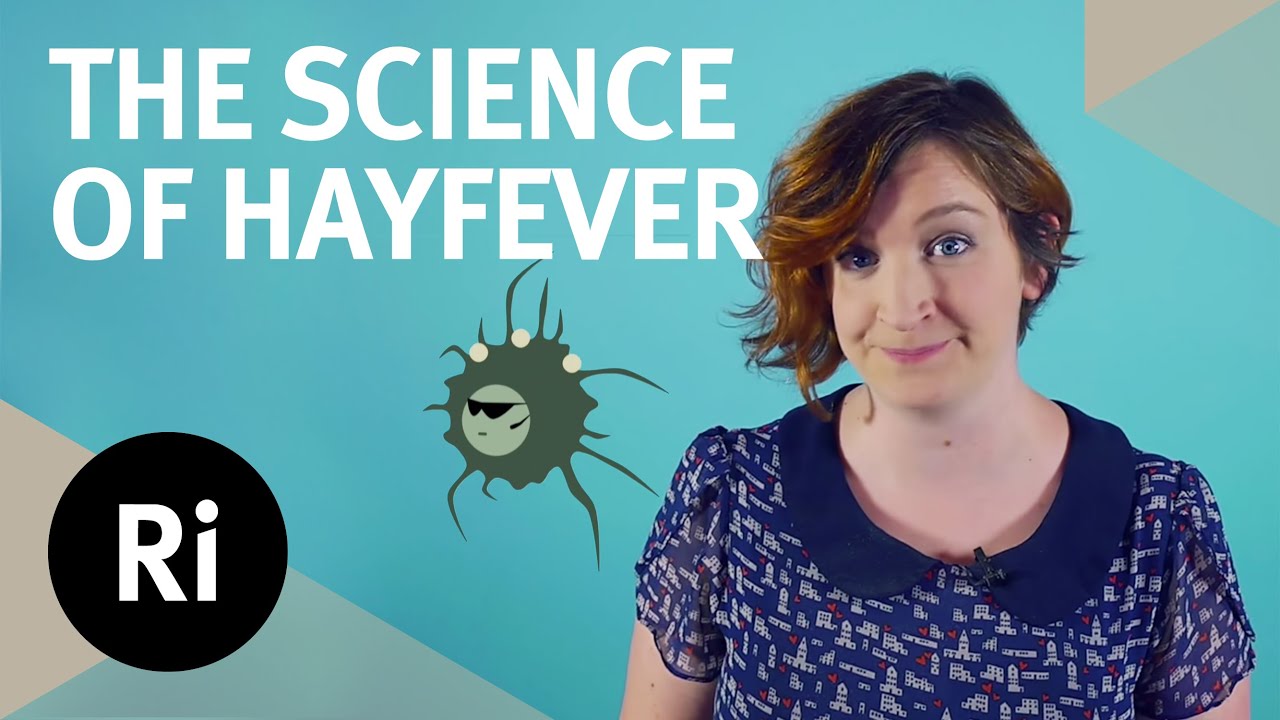The Royal Institution
Hay fever has an awful habit of ruining what should be the nicest time of the year. But what is it? And why is it called ‘hay fever’? Kate explores the science of allergies, and hunts through the research for a cure.
Subscribe for more from Kate: http://bit.ly/RiSubscRibe
How to prevent hay fever? Hay fever isn’t caused by hay, and isn’t really a fever. Allergic rhinitis is the technical name, but what’s it all about? At its centre, hay fever is an inflammation and irritation of the mucus membranes in the nose. Wind-pollinated plants hurl their pollen into the atmosphere, which finds its way into your nose and starts to wreak havoc. Much like other allergic reactions, hay fever is the result of your body fighting off the injected pollen as if it were a disease-causing invader. Antigen presenting cells, T cells and B cells launch into a hyperactive, over enthusiastic frenzy, ultimately causing symptoms that, although crucial when fighting off real infections, are a needless frustration.
Is there a cure? Not yet, but one strand of new research is finding hope in an unlikely source: parasitic worms. The idea is that the worms alter our immune system to avoid being repelled. These alterations just might hold the key to staving off hay fever, and finding summer happiness at last.
This film is part of our series that provides the blueprint for a scientifically perfect summer. Taking a different topic each Thursday, the videos will gradually build up an equation for summer perfection; a summer survival guide certified by science.
Subscribe to keep up each week: http://bit.ly/RiSubscRibe
REFERENCES
Anthony, R.M. et al (2007) Protective immune mechanisms in helminth infection. Nature Review. Immunology 7(12): 975-987
Bostock, J. (1828). Of the Catarrhus Æstivus, or Summer Catarrh. Medico-Chirurgical Transactions, 14(2): 437–446
Bozzetto S. et al. (2012) Asthma, allergy, and respiratory infections: the vitamin D hypothesis. Allergy 67: 10–17
Carlsten, Chris et al. (2012) Air pollution, genetics, and allergy: an update. Current Opinion in Allergy and Clinical Immunology. 12(5): 455-461
Croft, A.M. et al. (2012) Helminth therapy (worms) for allergic rhinitis. Cochrane Database of Systemic Reviews 4
Dickie, H.A. and Rankin, J. (1958) Farmer’s lung: an acute granulomatous interstitial peritonitis occurring in agricultural workers. Jama 167(9): 1069-1076
Janeway C.A. Jr. et al. (2001) Immunobiology: The Immune System in Health and Disease. 5th edition. New York: Garland Science
MUSIC + SOUND
Constance by Kevin MacLeod (incompetech.com)
Licensed under Creative Commons: By Attribution 3.0
http://creativecommons.org/licenses/by/3.0/
Volatile Reaction by Kevin MacLeod (incompetech.com)
Licensed under Creative Commons: By Attribution 3.0
http://creativecommons.org/licenses/by/3.0/
Life of Riley by Kevin MacLeod (incompetech.com)
Licensed under Creative Commons: By Attribution 3.0
http://creativecommons.org/licenses/by/3.0/
Blop Sound by Mark DiAngelo
Licensed under Creative Commons: By Attribution 3.0
http://creativecommons.org/licenses/by/3.0/
IMAGES:
“Necator Americanus L3 x1000 12-2007” by Jasper Lawrence
Licensed under GFDL via Wikimedia Commons
https://commons.wikimedia.org/wiki/File:Necator_Americanus_L3_x1000_12-2007.jpg#/media/File:Necator_Americanus_L3_x1000_12-2007.jpg
“H nana adultF” by Image contributed by the Georgia Division of Public Health. – DPDx Image Library: http://www.dpd.cdc.gov/dpdx/html/imagelibrary/g%2Dl/hymenolepiasis/body_Hymenolepiasis_il6.htm. Licensed under Public Domain via Wikimedia Commons – https://commons.wikimedia.org/wiki/File:H_nana_adultF.JPG#/media/File:H_nana_adultF.JPG
“Evermicularis SC posterior” by Division of Parasitic Diseases and Malaria (DPDM) of the Centers for Disease Control and Prevention – http://www.dpd.cdc.gov/dpdx/HTML/ImageLibrary/A-F/Enterobiasis/body_Enterobiasis_il2.htm. Licensed under Public Domain via Wikimedia Commons – https://commons.wikimedia.org/wiki/File:Evermicularis_SC_posterior.jpg#/media/File:Evermicularis_SC_posterior.jpg
“Hymenolepis diminuta scolex” by Public Health Image Library of Centers for Disease Control and Prevention, Image #370. Licensed under Public Domain via Wikimedia Commons – https://commons.wikimedia.org/wiki/File:Hymenolepis_diminuta_scolex.jpg#/media/File:Hymenolepis_diminuta_scolex.jpg”Arabis voch1-4″ by Marie Majaura – Own work. Licensed under CC BY-SA 3.0 via Wikimedia Commons – https://commons.wikimedia.org/wiki/File:Arabis_voch1-4.jpg#/media/File:Arabis_voch1-4.jpg
Dartmouth College SEM Facility
http://remf.dartmouth.edu/images/botanicalPollenSEM/
The Ri is on Twitter: http://twitter.com/ri_science
and Facebook: http://www.facebook.com/royalinstitution
and Tumblr: http://ri-science.tumblr.com/
Our editorial policy: http://www.rigb.org/home/editorial-policy
Subscribe for the latest science videos: http://bit.ly/RiNewsletter
Source




First
So worms shut down the detection system. How is this not HIV-like and dangerous?
I think I'll just keep to the antihistamines thank you.
They should market it as an additive to your micro biome. You have bacteria helping you digest food. Here is a small parasite that will live in your gut and it will cure your allergies.
I hope they can evolve these worms to be small, so it doesnt produce any wiggling discomfort. And that the strain the sell will be easily exterminated with some pills if need be.
These worms could solve nut allergies as well?
I wish i could try the worms today. Please!
Parasitic worms? I don't know whether my coworkers at the office would be great against hay fever.
There's a really great Radiolab episode on this. If anyones interested I'd recommend you give it a listen: http://www.radiolab.org/story/91689-parasites/
Worms that are less gross ? I laughed at that part!
Thank you for explaining very clearly.
I don´t know if I would rather to have a runny butt than a runny nose
🙂
Sorry, just kidding, no scientific base for that joke.
The problem is poor eating habits.
Go drink green, vegetable and fruit smoothies and you'll be cured.
I had a lot of allergies when I was young, I have nothing now because I eat well.
Mine causes by dogs fur. I have itchy eyes, sneezing and runny nose.
GIVE ME WORMS!
Sometimes i just want to burn all these fucking plants
I have hay fever but I take piriton
I love seeing how the immune system deals with invading cells
thumbs up if sneezing hurts like pits of hell
Lol helminths, no thank you. I'm gonna let this allergic rhinitis for a while, it's a great workout to my lower abdominal muscles.
i look like quasimodo and feel like hell I'm going to kill everyone
No, you don't actually have to swallow live worms. If you use Necator Amercanus they enter your body through your skin.
I GOT CONJUNCTIVITIS
I get so annoyed about my hay fever I get tree pollen mostly
my eyes acc ich or burn a lot
Yikes, allergies are the worst. Thanks for these helpful tips!
….. the best remedy is to shut your mouth firmly and breathe thru the nose …
So basically when it's windy just put your jacket around your face or cover you face?
Where can I sign up for that research? I don't mind swallowing that worm as long as it helps
I have very bad hay fever so in May, it’s like hell and I get a sore throat like I have Tonsillitis. I feel like I literally have Influenza!
When will it end for god sake
I'll take the hay fever. Will never infect myself with worms.
I have hay fever but I’m more affected by dust than pollen and stuff
OH HELL NO.
Take 1000 mg of vitamin C and you’ll feel the difference within minutes the congestion just goes away. I’m up to 6,000 mg of vitamin C (ascorbic acid non GMO)and my hay fever and post nasal went away within a few days. I don’t take anymore alegra D or any allergy medicine. Never did one doctor recommend vitamin C. But they gladly operated on me twice with no good results and more then 50k In Expenses insurances payed. VITAMIN C Heals everything look do your research people!!!
Wow the music was quite distasteful
Absolute madness
Western medicine …focuses on the symptoms not the source … Use quick fixes that suppress symptoms by causing a problem somewhere else ..thanks but no thanks
I’d rather be bunged up then sallow worms
2019 – still waiting 😀 <sneezes>